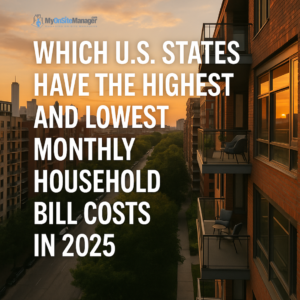Living costs in the U.S. continue to rise, but not all states are equally expensive when it comes to household bills. A new report from doxo—a leading bill payment service—sheds light on the 2025 Cost of Bills Index (COBI), ranking all 50 states based on the median monthly cost of essential household expenses. These expenses include mortgages, rent, utilities, auto loans, insurance, cable/internet, mobile phones, and more.
The report provides a snapshot of how much the average American household spends on essential bills each month, highlighting states where residents face the highest financial burden and those where bills remain relatively affordable.
How the Cost of Bills Index Works
The COBI calculates a median monthly cost for 13 key bill categories using real payment data from doxo’s platform. A score of 100 represents the national median, which is approximately $2,058 per month or $24,700 annually. States that score higher than 100 indicate above-average costs, while those with lower scores are more affordable.
This year’s findings come amid rising economic uncertainty, with inflation, higher interest rates, and increasing insurance premiums contributing to the overall burden on households.
Most Expensive States in 2025
According to the 2025 report, California tops the list as the most expensive state for household bills. On average, residents in California pay 39% above the national median, with high mortgage payments, expensive utilities, and elevated insurance premiums driving costs.
Other high-cost states include:
-
New Jersey – Known for its high property taxes and expensive utilities.
-
Hawaii – Elevated shipping costs and reliance on imported energy make living here costly.
-
Massachusetts – High housing costs and auto insurance rates push it into the top tier.
-
New York – While rural areas are cheaper, metro regions like NYC drive up the average.
Least Expensive States in 2025
On the other hand, West Virginia ranks as the most affordable state, with household bills averaging 44% below the national median. Low mortgage and rent costs are the biggest contributors to this ranking, with the median rent coming in at just $870 per month.
Other affordable states include:
-
Vermont – Lower housing costs and cheaper auto insurance.
-
Mississippi and Arkansas – Utility and housing costs are significantly below national levels.
-
South Dakota – Known for low overall cost of living and affordable energy.
Category Breakdown of Monthly Bills
The index reveals striking differences in individual bill categories:
1. Housing Costs (Mortgage and Rent)
-
Highest: California, New Jersey, Hawaii, Massachusetts, New York.
-
Lowest: West Virginia (mortgage $1,019/month, rent $870/month).
2. Auto Loans
-
Highest: Nevada ($559/month) and Hawaii ($520/month).
-
Lowest: West Virginia ($165/month) and Vermont ($395/month).
3. Auto Insurance
-
Highest: Massachusetts ($167/month) and Delaware ($156/month).
-
Lowest: West Virginia ($70/month) and Kansas ($46/month).
4. Utilities (Gas and Electric)
-
Gas: Alaska ($136/month) and Massachusetts ($117/month) are highest.
-
Electric: Hawaii ($197/month) and Rhode Island ($184/month) top the list, while South Dakota is lowest ($79/month).
5. Waste & Recycling
-
Highest: Massachusetts and Maryland (~$127/month).
-
Lowest: Oklahoma ($25/month) and Hawaii ($34/month).
6. Water & Sewer
-
Highest: Maryland ($189/month) and Washington ($162/month).
-
Lowest: Tennessee and Alabama (~$55/month).
7. Cable & Internet
-
Highest: Delaware ($157/month) and Rhode Island ($150/month).
-
Lowest: Arkansas ($99/month) and Florida ($96/month).
8. Mobile Phone
-
Highest: Nebraska ($136/month).
-
Lowest: Illinois ($71/month).
9. Health Insurance (Consumer Portion)
-
Highest: Alaska ($235/month) and Rhode Island ($170/month).
-
Lowest: Georgia ($30/month) and Florida ($50/month).
10. Life Insurance
-
Highest: Minnesota ($83/month).
-
Lowest: Nevada ($47/month).
11. Alarm & Security
-
Highest: West Virginia ($110/month) and California ($100/month).
-
Lowest: Georgia ($63/month) and Alabama ($54/month).
The Hidden Costs of Monthly Bills
In addition to the $2,058 median monthly spend, doxo found that hidden costs add roughly $1,495 per household annually. These hidden costs include:
-
Late payment fees
-
Overdraft fees
-
Identity theft losses
This means the true cost of bills could exceed $26,000 per year for many households.
Why Do Costs Differ by State?
The variations in household bill costs are influenced by several factors:
-
Housing Market Trends: States with expensive real estate markets, like California and New York, naturally have higher mortgage and rent costs.
-
Energy Sources: States relying on imported or non-renewable energy tend to face higher utility bills.
-
Taxes and Insurance Rates: Property taxes and state-level insurance regulations significantly affect monthly expenses.
-
Urban vs. Rural Divide: Metro areas like Los Angeles or New York City drastically increase the state average.
What Can Households Do to Manage Costs?
If you live in a high-cost state, here are a few tips to ease the burden:
-
Bundle services (e.g., cable and internet) to reduce monthly fees.
-
Shop around for insurance, as rates vary significantly between providers.
-
Invest in energy-efficient appliances to lower utility bills.
-
Set up autopay to avoid late fees and take advantage of discounts some companies offer.
Conclusion
The 2025 doxo Cost of Bills Index highlights the growing disparities in monthly household expenses across the U.S. While states like California and New York struggle with skyrocketing costs, areas like West Virginia and Vermont provide a more affordable lifestyle.
For anyone considering relocation, budgeting, or financial planning, understanding these trends can help make smarter decisions in 2025 and beyond.
Source
Original article: CNBC – The most—and least—expensive U.S. states based on the median monthly costs of essential household bills.
Read the full article here.

